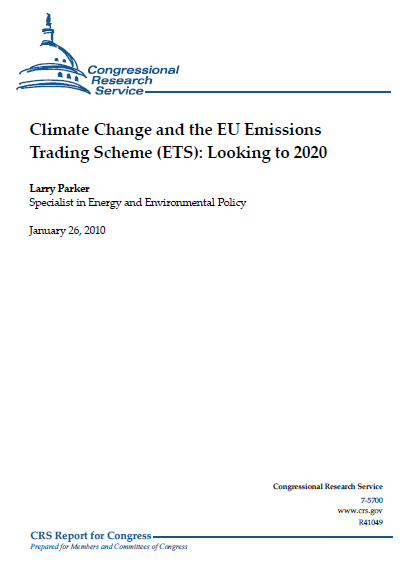 CRS Report
CRS Report
- R41049
- Larry Parker, Specialist in Energy and Environmental Policy
- January 26, 2010
The European Union’s (EU) Emissions Trading Scheme (ETS) is a cornerstone of the EU’s
efforts to meet its obligation under the Kyoto Protocol. It covers more than 10,000 energy
intensive facilities across the 27 EU Member countries; covered entities emit about 45% of the EU’s carbon dioxide emissions. A “Phase 1” trading period began January 1, 2005. A second, Phase 2, trading period began in 2008, covering the period of the Kyoto Protocol. A Phase 3 will begin in 2013 designed to reduce emissions by 21% from 2005 levels.Several positive results from the Phase 1 “learning by doing” exercise assisted the ETS in making the Phase 2 process run more smoothly, including: (1) greatly improving emissions data, (2) encouraging development of the Kyoto Protocol’s project-based mechanisms—Clean Development Mechanism (CDM) and Joint Implementation (JI), and (3) influencing corporate behavior to begin pricing in the value of allowances in decision-making, particularly in the electric utility sector.
However, several issues that arose during the first phase were not resolved as the ETS moved into
Phase 2, including allocation schemes and new entrant reserves, and others. A more
comprehensive and coordinated response by the EU has been made for Phase 3 with harmonized
and coordinated rules being developed by the European Commission.The United States is not a party to the Kyoto Protocol. However, five years of carbon emissions
trading has given the EU valuable experience in designing and operating a greenhouse gas trading
system. This experience may provide some insight into cap-and-trade design issues currently
being debated in the United States.• The U.S. requires only electric utilities to monitor CO2. The EU-ETS experience
suggests that expanding similar requirements to all facilities covered under a capand-
trade scheme would be pivotal for developing allocation systems, reduction
targets, and enforcement provisions.• In the U.S. debate continues on comprehensive versus sector-specific reduction
programs; the EU-ETS experience suggests that adding sectors to a trading
scheme once established may be a slow, contentious process.• As with most EU industries, most U.S. industry groups either oppose auctions
outright or want them to be supplemental to a base free allocation. The EU-ETS
experience suggests Congress may want to consider specifying any auction
requirement if it wishes to incorporate market economics more fully into
compliance decisions.• EU-ETS analysis suggests the most important variables in determining Phase 1
allowance price changes were oil and natural gas price changes; this apparent
linkage raises possible market manipulation issues, particularly with the inclusion
of financial instruments such as options and futures contracts. The EU will
examine the matter in preparation for Phase 3. Congress may consider whether
the government needs enhanced regulatory and oversight authority over such
instruments.
